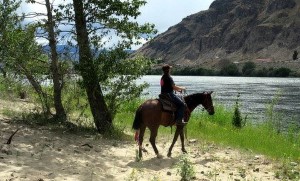
I was recently asked to describe a maneuver I call the “emergency brake.”
It is fundamentally a two-handed stop which is used in a variety of disciplines for a variety of training reasons.
I am describing it here for that use, as well as for the safety of everyone.
It can be used as a stopping maneuver (training or emergency.)
The context in which I was asked the question was all about safety and the ability to stop a horse quickly and efficiently.
In order to get the desired effect in a “pressured” situation, you must practice the movements outlined below so that they flow automatically.
That takes slow practice at first. I recommend you begin by getting the correct sequence of hand motions just sitting still on a horse. From there you can try a back up from a stand still. Then walk get a stop with your emergency brake, two-handed stop. Build from there.
Here is the sequence:
1. Sitting aboard your horse, pretend like your arms and legs are connected to your trunk via hinges. Your four limbs can move freely without your trunk moving forward, backwards or to the sides.
2. Lift the reins in your reins hand straight up toward the sky about 6-8 inches in front of your saddle.
As you lift your hand, take the slack out of the reins. You are not going to do anything at this moment but get the motion of the direct lift Northward. Remember, your arms are on hinges … no upper body movement.
3. With your rein hand still elevated, slide your non-rein hand all the way down both reins all the way to barely touching the horse’s mane. Take all of the slack out of reins. You should be about 8 inches or so in front of the swell of the saddle.
4. With a smooth motion, pull the reins towards your abdomen with the hand that just slid down the reins. Your hands should not be hovering above the mane. Stay low and right along the mane.
5. In summary, here are the keys. Keep your trunk stable. Lift the reins straight up and then slide the other hand all the way down to the horse’s neck. This will give you maximum leverage and because your hand is low, it will help you maintain a low center of balance.
6. Now use that second hand and get a few steps back. Release.
7. Next walk, drop your seat and smoothly use your new brake to stop and take a few steps back. Release.
8. Practice until you do this sequence seamlessly and accurately.
“The Emergency Brake/Two-Handed Stop”
No responses yet